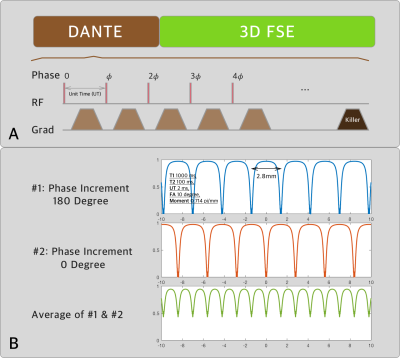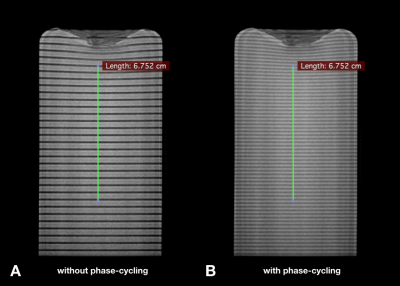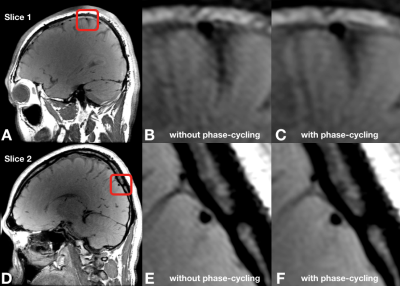1891
Banding free DANTE prepared vessel wall imaging incorporating multiple acquisition and phase cyclingJianxun Qu1, Tianye Lin2, Xiaocheng Wei1, Bing Wu1, and Feng Feng2
1GE Healthcare, Shanghai, China, 2Radiology, Peking Union Medical College Hospital, Beijing, China
Synopsis
Phase cycling was used to address the banding artefact in DANTE prepared black blood imaging. Simulation, phantom and in-vivo experiment were performed to illustrate and validate the effectiveness
Introduction
Delayed alternating with nutation for tailored excitation (DANTE) preparation module has gained increasingly popularity in black blood imaging. An essential steady state free precession (SSFP) sequence, composed of non-selective radiofrequency pulse (RF) and flow dephasing gradient of the same moment and polarity, is used to achieve flow suppression while maintain steady state for static tissue. Banding artefact, as induced by constant phase offset in present of dephasing gradient, persists in DANTE prepared images. Increasing dephasing gradient moment could reduce the spatial period of banding and thus make the artefact inconspicuous. However, banding was merely hided but not truly eliminated and its effectiveness was usually compromised at the cost of increased eddy current and prolonged unit duration. In cases where dark band resides adjacent and parallel to small vessels, the lumen size could potentially be exaggerated. Phase cycling is a conventional method adopted in SSFP for banding suppression. In high resolution vessel wall imaging (VWI), multiple acquisition is usually performed to guarantee sufficient signal to noise ratio (SNR). This study aims to achieve banding free DANTE prepared VWI incorporating multi-acquisition and phase cycling.Method
The spatial period of banding artefact is determined by the dephasing gradient moment in DANTE preparation. Such banding pattern could be shifted via changing the phase increment of the series RF pulses. In multiple NEX acquisition, banding patterns with different offset could be averaged to reduce the spatial period and thus reduce the artefact. A phase cycling scheme could be adopted for phase increment in multiple NEX acquisition. Simulation, phantom, and in-vivo exam were performed to illustrate and validate its improvement. First, banding artefact pattern with phase increment of 180 degree and 0 degree was simulated to visualize the pattern shift. The simulation system parameters are: T1/T2 1000/100ms, dephasing gradient moment 0.714 pi/mm, flip angle 10 degree. The DANTE preparation unit was repeated for 100 times with a time step of 2us. Then, DANTE prepared 3D fast spin echo (FSE) sequence (Figure.1A) with and without phase cycling was implemented in a 3.0T whole body system (Discovery 750, GE) for phantom and in-vivo study. The DANTE preparation parameters for phantom validation are: dephasing gradient moment 0.563 pi/mm in readout direction, flip angle 10 degree, repeated number 100, unit time 2ms. The banding artefact was visualized by 3D FSE sequence with in-plane resolution of 0.5*0.5mm. Later, a healthy volunteer was recruited with consent acquired prior to examination. In-vivo experiment was performed with clinically adopted settings: DANTE gradient moment of 1.126 pi/mm in slice selective, phase encoding, and readout direction with flip angle, unit duration, and repetition number the same as that of phantom study. A sagittal slab was prescribed for cranial black blood imaging with TE/TR 13/700ms, FOV 200*200mm, Matrix 288*288, slice thickness 1.2mm, slice number 64, echo train length 32, parallel imaging acceleration factor 2, and average number 2. The banding artefact with and without phase cycling was evaluated visually.Results
The simulation result with different phase increment scheme was presented in Figure.1B. The spatial period of banding artefact was 2.8mm, corresponding to (2pi) /(0.713pi/mm). A half period shift was observed between #1 (phase increment 180) and #2 (phase increment 0). In averaged pattern, the banding period was reduced by half and the depth of dark band was also elevated, which was also validated in phantom study. Figure.2A adopted single phase increment of 180 degree, while Figure.2B used phase-cycling scheme. In-vivo experiment result was shown in Figure.3. In zoomed region of interest from different slices (Figure.3 A D), conspicuous banding artefact was observed in images without phase-cycling (Figure.3 B E), compared to those with (Figure.3 C F).Conclusion
In this work, multiple acquisition and phase cycling are incorporated and implanted in DANTE prepared VWI. Simulation and phantom experiment were used to demonstrate and validate its effectiveness. The signal lost in the banding artefact was retrieved with multiple acquisition and phase cycling. In-vivo exam was also performed. Banding artefact was greatly reduced or eliminated with phase cycling modulation. Its effectiveness is to be further evaluated, especially for small vessels.Acknowledgements
No acknowledgement found.References
[1] Linqing Li, and etc. Radiology, 2014
[2] Linqing Li, and etc. MRM, 2012


